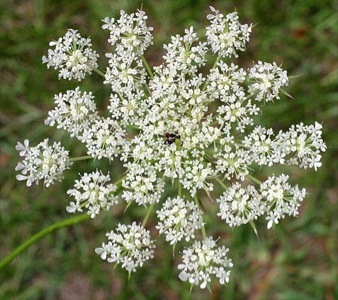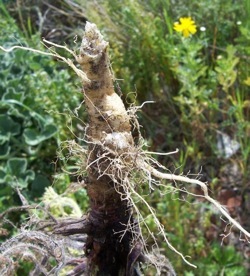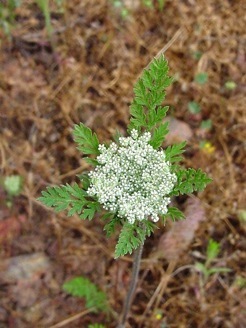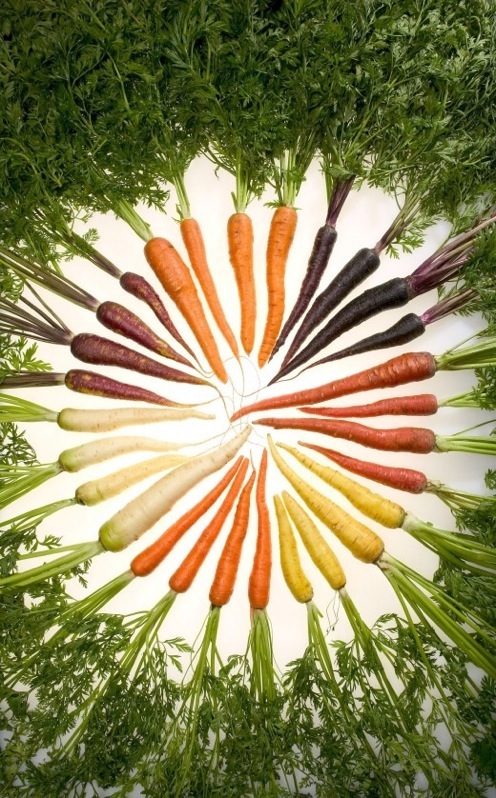Daucus Carota & Pusillus: Edible Wild Carrots
I’ve never understood the confusion over identifying the Wild Carrot also called Queen Anne’s Lace: It has a flat white blossom with a red spot in the middle, hairy stems and stalk, and the white root that smells like carrot. As the blossom ages it folds up looking like a bird’s nest. That seems quite easy to me, and was when I was a kid. Wild carrots were a common pasture plant. I tried eating more than one root raw, along with some dirt. The key is to find them at the end of their first year before the roots grow woody their second year. However, often that woody part can be peeled off and the root made edible.
As straight forward as it seems some experts say the Wild Carrot only occasionally has a red flower in the middle. Really? I’ve never saw one without it when I was younger. That said, the above description is for the Daucus carota (DAW-kus ka-ROT-a) a wild carrot imported from the Old World and known everywhere in the United States as “Queen Anne’s Lace.” But, there was a native carrot in North America when the Pilgrims arrived, the Daucus pusillus (DAW-kus pew-SILL-us.) It does not have a red dot.
D. pusillus is found in the southern half of the United States and up the west coast to British columbia. Much smaller than the D. carota, its root are none the less edible, though that is not saying much. It tends to have flowers that are white to pink and white, again no red dot. Like the import, the stems are hairy. The hairy stems and stalk is a very important identification element and separates the two carrots from very deadly members of the same family, such as Poison Hemlock which has a hairless stalk.
The Daucus carota is loosing some of its luster. A majority of states (at least 35 of them) list it as a pest or a noxious weed. It is particularly bad in Missouri. Apparently D. carota germinates easily and mowing doesn’t get rid of it. Some say the dried seed heads are a fire hazard and a threat to the honey industry. Another flower of the field demonized. My advice: Eat The Weeds! (See recipe on bottom)
Daucus pusillus, also called the American Wild Carrot and Rattlesnake Weed (I think nearly everything has been called Rattlesnake Weed) is a simple to few-branched annual that grows to three feet tall but usually less. The stems are covered with stiff hairs. The leaves are alternate, pinnate and compound on stems to six inches long. The umbrella-arranged flowers have five white petals and five stamens. It has fewer florets per cluster than the D. carota, 5 to 12, instead of 20. It likes dry ground, rocky to sandy soil, oak forests. Blooming time is April to June. The roots are similar to the D. carota, just smaller.
Unlike many native plants there’s not much evidence most Native Americans made much use of the D. pusillus. Eastern tribes ignored it, perhaps, records on them are scant. Only six western Indians seem to have used it. The Nez Perce and Navajo ate the roots, boiled or raw. They also used it to ‘clean the blood,’ stop itching, treat fevers and treat snake bite. A decoction and or a chewed poultice was used to treat snake bite. The Clallam, Cowichan, Saanich and coastal Salish also ate the root.
One way to get a steady source of good wild carrot roots is to grow them yourself. They sprout readily. Collect the seeds in the fall and set them out in the spring. Under cultivation they grow large, tender roots. The root of Queen Anne’s Lace is likely a direct ancestor of the modern carrot which has been under cultivation for some 5,000 years, probably starting in Afghanistan. While the wild carrot root is cream colored to light orange there are a number of varieties including white, yellow, red, purple, green, black, striped and purple on the outside and orange inside. The orange carrot is believed to have been developed in the 16th century in Holland, where patriotic plant breeders developed it to celebrated the Royal House of Orange.
Incidentally, that cultivated carrot you bought or grew? The green tops are quite edible cooked. Add them to a variety of boiled dishes for flavor, or boil them separately and add them to other dishes as greenery.
The name Queen Anne’s Lace was adopted because Queen Anne of Great Britain was adept at making lace. They carried the allusion farther by saying the red flower in the middle is when she pricked her finger and a drop of royal blood fell on the flower.
Daucus is from the Greek word THAV-kon) meaning carrot parsnip and other similar food plants. Carota is from the Greek ka-ROW-ton, also meaning carrot is from the Indo European word Ker, meaning head or horn. Pusillus is Latin for tiny or puny.
Daucus plants can make cattle and horses “nervous.” The toxicity is consider mild.
Queen Anne’s Lace Jelly
18 Large Queen Anne’s lace heads
4 Cups water
1/4 Cup lemon juice (fresh or bottled)
1 Package powdered pectin
3 2/3 Cups
Bring water to boil. Remove from heat. Add flower heads (push them down into the water). Cover and steep 30 minutes. Strain.
Measure 3 Cups liquid into 4-6 quart pan. Add lemon juice and pectin. Bring to a rolling boil stirring constantly. Add sugar and stir constantly. Cook and stir until mixture comes to a rolling boil. Boil one minute longer, then remove from heat.
Skim. Pour into jars leaving 1/4″ head space. Process in hot water bath for 5 minutes. Makes about 6 jars.
Green Deane’s “Itemized” Plant Profile
IDENTIFICATION: Daucus carota: An erect, biennial herb; leaves basal and alternate, two-pinnately divided with narrow segments; flowers small, white, in a terminal, umbrella-shaped cluster; 20 florets, often with red spot in middle; seed small, dry, ribbed, with bristly hairs. Roots smell of carrots.
TIME OF YEAR: Roots in fall, blossoms in season
ENVIRONMENT: Full sun to partial shade, fields, pastures, meadows, rocky soil even clay.
METHOD OF PREPARATION: Roots cooked or if you have good teeth, raw. Thin and stringy. The flower clusters can be french-fried for a carrot-flavored gourmet’s treat. Aromatic seeds good for flavoring soups and stews. Dried roasted roots can be are ground into a powder and used as a coffee substitute.





